
CLEARFIELD – The Pennsylvania Economy League made a presentation to the Lawrence Township Supervisors at yesterday’s re-scheduled meeting.
PEL is the group helping to guide the township and Clearfield Borough through the process for a possible consolidation.
The presentation was on the demographics and finances for the township, comparing where the township has been and what PEL projects for the next five years.
PEL made a similar presentation to Clearfield Borough last week. Members of the committee from Clearfield also attended the meeting to get an idea of where the two municipalities stand in relation to each other.
Supervisors Bill Lawhead and Randy Powell were present for the meeting while Supervisor Dan Mitchell was absent.
In regards to demographics, there has been an overall decline in population from 1990 to 2010 when the last census was taken. This includes what is referred to as the wage-earning population of 18-64.
Although the overall population declined, there was a slight rise in those aged 65 and older, and those people are usually on fixed incomes.
Median housing values and household income are significantly lower than the state and grew at a slower rate. Gerald Cross of PEL explained this can often lead to blight conditions, especially if vacant property numbers continue to rise.
The group then reviewed the history of the township’s finances. There have been significant expenditures in public works and fire since 2012 and the township used both Act 13 money and the general fund.
Part-time police costs were also funded through Act 13, and the supervisors were warned they should not be relying on Act 13 money for funding something like police.
In 2014, there was a significant deficit in the township’s budget, which was made up with a cash balance. Additionally, most of the tax income growth has been in Earned Income Tax and real estate showed flat growth.
In regards to millage, the township is currently at 16 mills, which is over the maximum rate set for second-class townships.
The township had to get permission from the court to raise the millage by two, and can obtain an additional three mills this way, and that is the absolute limit.
The most notable expenditures are pension costs, which went up 145 percent in the past five years and health insurance, which the township has taken proactive costs to lower.
Cross said one thing that would help all the municipalities in the county would be a reassessment. The last property reassessment in the county took place in the 1980’s.
Cross noted that one reason commissioners resist reassessment as it can be political suicide. However, millages often go down after reassessment.
“Unless a reassessment is on the horizon, you’re stuck at 16 mills,” Cross stated. He added that services are being demanded, but no one wants to pay increased taxes and the township will have to make difficult decisions soon.
The next section covered projections for the next five years.
Again, Cross warned the supervisors they need to stop depending on Act 13 money. C. Alan Walker, who is a member of the consolidation committee, pointed out that the money coming from the gas wells could be altered if a severance tax is added or if Act 13 is eliminated and the severance tax takes its place.
Both he and Cross emphasized that rural areas, such as Clearfield County, would not see any severance tax money, it would all go to the big cities such as Philadelphia.
The findings for the future include the following. If Act 13 money remains at about $400,000 and capital expenditures at $200,000 and general fund expenditures at $200,000, deficits begin in 2017 and the cash balance will be reduced by $1 million over the next five years. If Act 13 money disappears, deficits start in 2016 and the cash balance will be depleted by 2020.
In regards to sewer, there were deficits in 2011 and 2012 and two rate increases in 2013 and 2015. Projections indicate a surplus, but the township also has more work to be done on the sewer system.
PEL then presented financial recommendations, pointing again at the millage rate in the township with little projected revenue growth.
Options to increase revenue are limited and PEL said it is not a good idea to borrow money or use special debt millage to raise revenue.
Ultimately, the township will need to consider expenditure reductions. Cross said anyone can remove a little flotsam here and there and maybe reduce the budget 1-2 percent, but what the township will need to do is make big cuts in services and capital projects. The representatives of PEL also made suggestions for budgeting to help keep track of where money goes.
Walker then asked how the township compares to Clearfield Borough and Cross said they are very similar in demographics, housing, financing, etc.
“From an outsider point of view, you look the same,” he said. According to Cross, borough millage is at 25 and they could go up 10 more, five of that 10 with court approval. Additionally, Act 13 money took a hit this year, dropping over $35 million from the year before.
It was noted that this is the reality in most Pennsylvania municipalities. Here, the township, borough, county, school districts, etc. are all facing decreased population, which results in decreased tax base.
The next meeting of the consolidation committee will be Tuesday at 6 p.m. at the Clearfield Borough Building. All meetings are open to the public.


